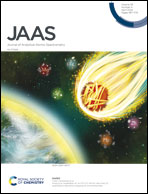Analysis of hydrogen in a hydrogenated, 3D-printed Ti–6Al–4V alloy by glow discharge optical emission spectroscopy: sample heating effects
Abstract
Depth profile analysis of a hydrogenated Ti–6Al–4V alloy by glow discharge optical emission spectroscopy (GDOES) is described. Besides the earlier reported ‘hydrogen effects’, causing changes in emission intensities of other elements if hydrogen is present, the analysis of hydrogen itself was found to be affected by the redistribution of hydrogen in the region adjacent to the analyzed spot, due to sample heating and the thereby increased hydrogen diffusivity. A simple model of heat transfer within the sample during the GDOES analysis is proposed and the surface temperature of the analyzed spot is estimated to be ≈365 °C, in the given experimental setup.



 Please wait while we load your content...
Please wait while we load your content...